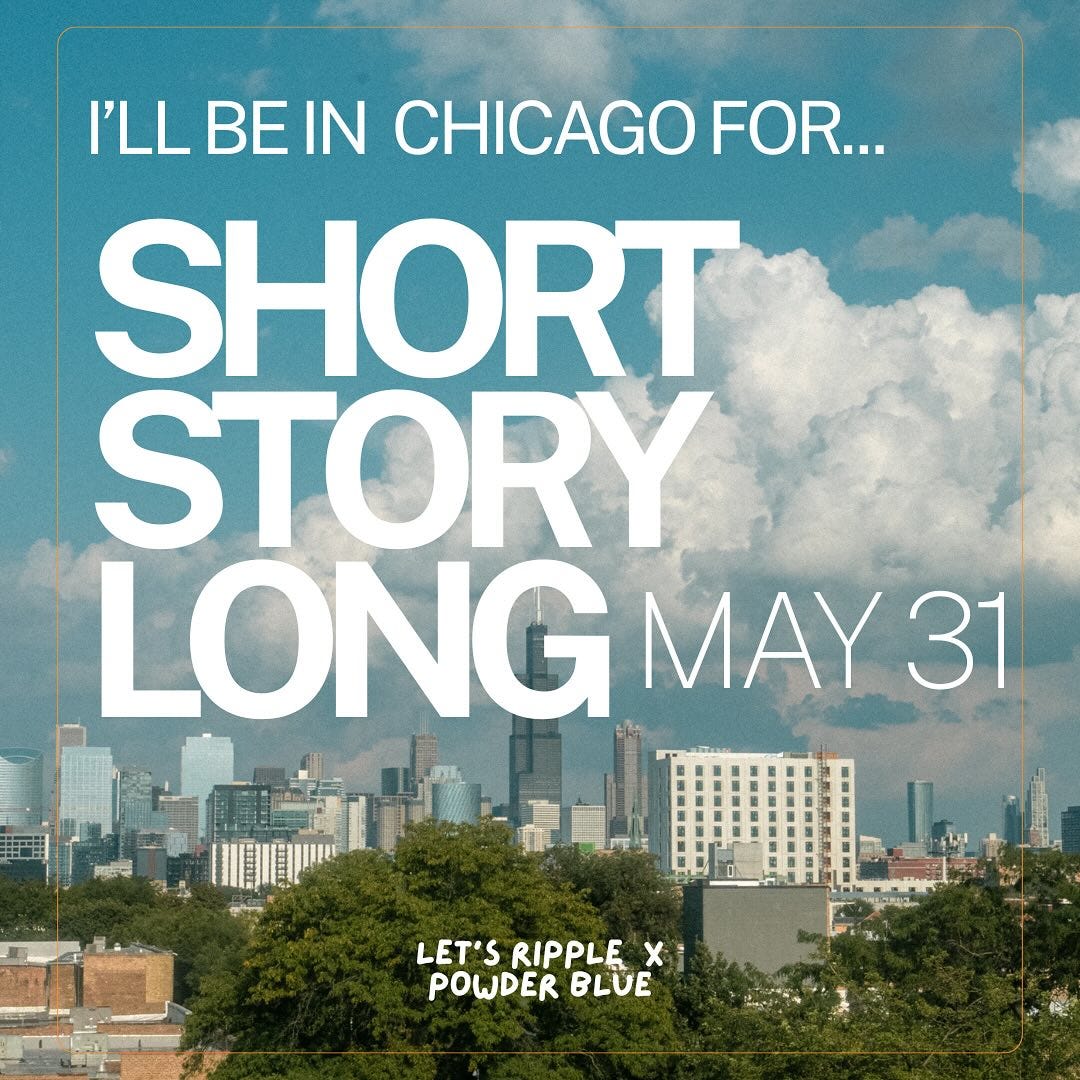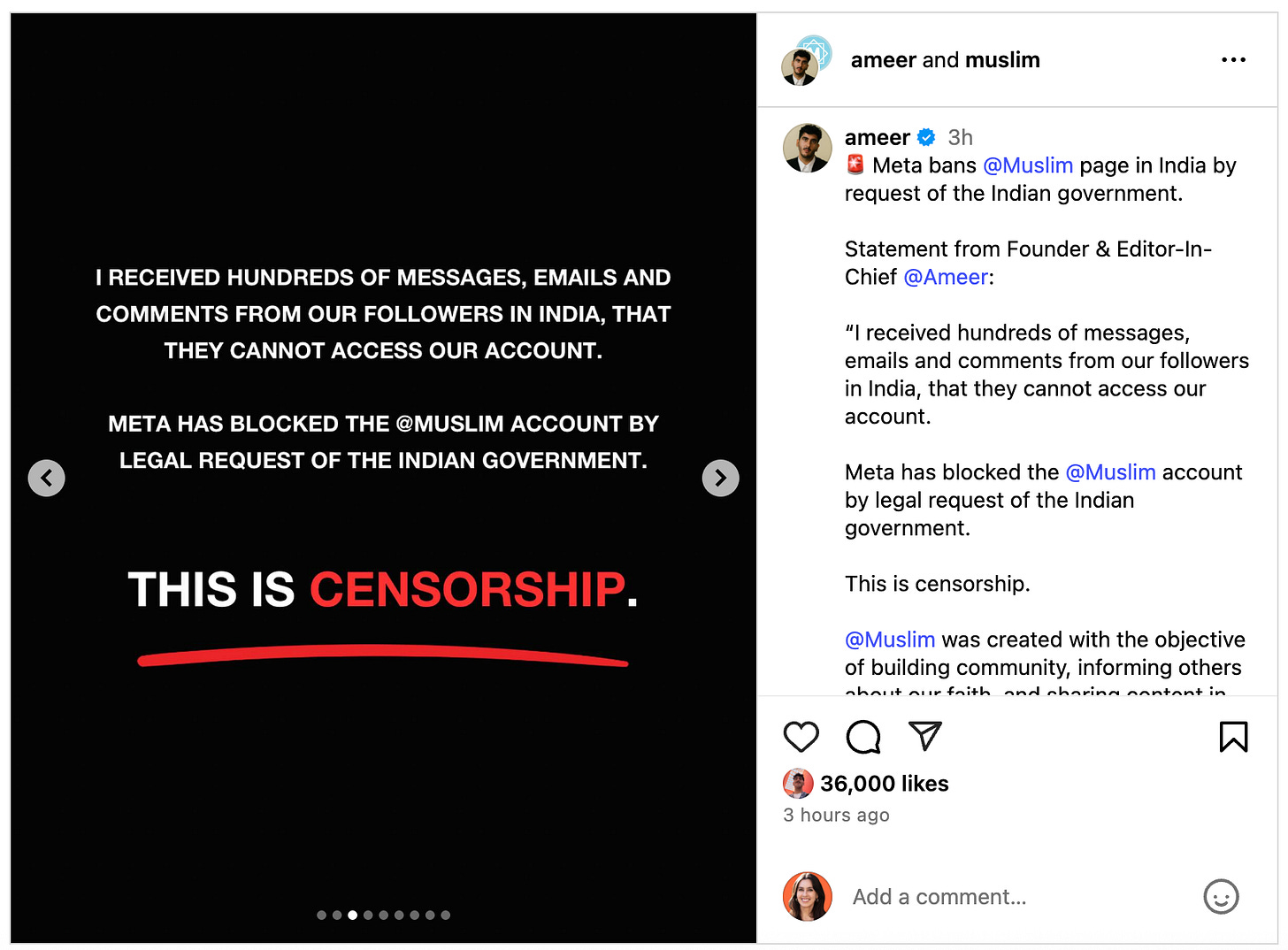Is Art the Cure to Burnout? 🖌️
And four other things I think (I think)
blog.fifty-nine // ICYMI: We’re hosting a full day of storytelling on Saturday, May 31…and tickets are available now.
“Short Story Long,” has the whole team pumped for a number of reasons. For one: Scott Whitehair, an award-winning verbal storyteller, will be leading our workshop—as well as telling a story (or two).*
Another reason: The event is taking place right here in the Windy City! With Summertime Chi right around the corner, we can’t wait to show off our city-wide backyard to everyone flying in—and catch up with all of our neighbors from around the block.
Finally, any chance we get to gather a group of 80+ individuals to laugh, cry, and tell some damn good stories is a chance worth taking. Selfishly, I can’t wait to see all of the new relationships and collaborations that sprout from the weekend after next.
As a Creator Mag reader, you actually receive 15% off your “Short Story Long” tickets when using code “THEBLOG” at checkout. But act fast—this discount is only available until Thursday!
Alright, onto today’s blog. Here’s a new edition of “Five Things I Think (I Think).”
— NGL
P.S. Last blog, we talked with illustrator and creator Katie Mai about life after burnout and filling your creative cup. You can read it here.
One :: I think art just might be the cure to burnout. Okay, okay—I can’t take credit for the title of this evening’s blog. It was pulled directly from a recent video essay by the YouTube channel Sisyphus 55.
I’ve seen this video everywhere over the last month. It kept popping up on my YouTube homepage, and Shua even dropped it into our Slack. But I didn’t sit down to watch it until this week—and I’ve been thinking about it even more, particularly given our recent conversation with Katie Mai on the topic of burnout.
The case Sisyphus 55 makes is simple: Burnout comes from boredom, of not knowing where all of these small, repetitive steps are leading us towards.
“How come every time you move forward, you find yourself paralyzed in action just a few months later?
Colors don’t glow. Light doesn’t shine. Trying to find out what matters becomes the only thing that matters.”
I’ve certainly experienced this feeling in the past. I’m sure you have as well.
These days, we’re often told to “find our format”—i.e. something we can make over and over and over. Whether it’s a newsletter that serves a particular niche or a shortform video series with a similar beginning, middle, and end, this framework certainly succeeds in making creative work more manageable over the long run.
Now, in a strange way, I do believe that artists are more like athletes than we give them credit for. You need to show up, put in the reps, and take shots on goal. They won’t all go in, but when they do, it’s because of the weeks, months, and years of preparation preceding the goal.
But if that preparation all starts to look the same, it’s easy to hit a creative rut. And in Sisyphus 55’s eyes, the key to getting out of that rut is exploration, and experimentation. It’s tinkering with the zeroes and ones in the algorithm found in our cranium. It’s creating art.
“The boredom fades away as the curiosity compels you back to the moment.”
There’s nothing wrong with formats—they serve as a great way to build up our creative muscles. Yet whether it’s playing a different key on a piano or tweaking a newsletter column ever-so-slightly, we still need to make the space required to engender our own curiosity.
Two :: I think the current “independent journalism” route doesn’t incentivize real reporting. Following her recent story on Meta’s decision to censor the biggest Muslim news account in India (at the behest of the Indian government), tech and culture journalist Taylor Lorenz posted the following on Substack Notes:
I landed a big scoop and I lost paid subscribers. Meaning I lost hundreds of dollars doing this story and trying to hold Meta accountable for censorship.
Not to be whoa is me bc I'll be fine! But trying to pay rent every month means deciding which stories to spend time on, and every single incentive structure on the internet pushes you against challenging power.
For what it’s worth, I thought the story—which Lorenz shared through her Substack publication, User Mag—was really good, and necessary, particularly as the tensions between India and neighboring Pakistan have reached a violent boiling point.**
Nevertheless, I agree whole-heartedly with the point she’s making here. A lot of newsletters have devolved to roundup-style link dumps because, quite frankly, it’s much easier than a) actually getting on the phone with sources b) reporting something original c) fact-checking that writing and d) running the risk of getting sued into bankruptcy—if people even end up caring about your story anyway.
I’ve experienced this myself since going independent. One story from our last zine took over three months to report; when I sent it out over email, it had a forty-two percent open rate. Later that week, I wrote a quick event blast in fifteen minutes…which received a forty-eight percent open rate.
We do the deeper work because we think it’s important. We’ll continue to do the deeper work because we think it’s important. And besides, it’s not just an “independent journalism” thing. A lot of The New York Times’ recent subscriber growth can be attributed to Wordle, after all—not its extensive reporting. One tends to fund the other.
Still, the broader point Lorenz is making here rings true, and the business model behind the booming “independent journalism” ecosystem has a long way to go.
Three :: I think hating-as-a-growth-mechanism is a tired shtick. If the above mini-essay was your first time hearing of Substack Notes, yes, the email newsletter platform pretty much rolled out their own Alternative Twitter back in 2023.
The pitch was simple: T̶w̶i̶t̶t̶e̶r̶ X now stinks, and by posting similar content on Notes, it was a new way to increase discovery for your Substack publication.
Thing is, when you open Notes, the posts that do go viral tend to feel the same. Popular formats include:
Asking people to drop their Substacks in the comment section “so we can all follow each other”
Thought leadership copypasta
Hating on Notes (and Substack in general)
I’m not the only one who’s picked up on the latter format. Author and journalist Ross Barkan posted this recently:
“Funniest/worst Substack type is the pundit person who resents being here and makes that their shtick and deep down knows they probably have to be here but the resentment keeps growing.
Part of them hopes ‘hating’ brings a bigger following (sort of worked on 2010s Twitter) and gets crankier when that doesn’t work.”
Yes, the modern media landscape can be uninspiring at times. But if you’re gonna play the platform game, the process of hating as an obvious marketing “strategy” proceeds to make that landscape even more uninspiring.
Four :: I think The Rehearsal is the best thing I’ve seen in years. I won’t spoil anything, but if you’re not watching Season Two of Nathan Fielder’s genre-bending HBO series…wyd?
Sure, Fielder’s style of comedy (honed on Comedy Central’s cult classic show, “Nathan For You”) isn’t for everyone. But as he investigates the reasons behind our most destructive plane crashes—and even attempts to identify potential solutions—the comedian presents a fascinating, season-long question:
Can you ever be taken seriously when the whole world views you as a clown?
I highly recommend tuning into the journey to answer that question.
Five :: I think we have a new series for you, coming soon. I started this blog last fall to reconnect with friends and family—while sharing insights on what’s in my purview.
The same spirit remains, and this “Five Things” column will return most Sundays. However, thanks to the surge of guest submissions we received, we’ll also be publishing some excellent essays from you, our readers. Plus: An entirely new format on Thursdays following the last conversation from our “Twenty-Five Calls” series.
Stick around for a while, ‘cause things are about to get gooooood.
Thanks for reading! Shoot us a reply, comment, or DM if anything resonated with you in particular—we respond to them all.
* I kid you not, this guy is one of the most talented storytellers I’ve ever had the chance to see perform. You can learn more about Scott here.
** More context here if this is your first time hearing about the conflict.








